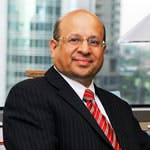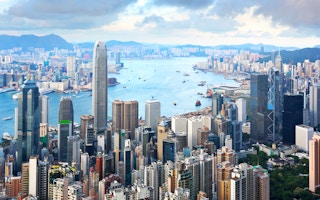Having been an engineer for about four decades, Dr Bindu N. Lohani of the ADB knows first-hand how science – and technological solutions – hold the key to solving one of the world’s biggest challenges: climate change.
Besides emphasising the fact that engineering innovations in areas such as energy efficiency and renewable energy are vital to climate change mitigation, Dr Lohani adds that there is also technology that already exists that can help governments “climate proof” infrastructure to adapt to climate change. These include materials composition such as temperature-resilient paving materials; design, for example, porous pavement to accommodate more intense precipitation; and location of infrastructure to reduce risks from rising sea levels.
At the same time, the engineering community needs to challenge itself and devise ways to overcome existing technological limitations, he says.
The first is air travel, for which no economically viable alternative to carbon-based fuels exists. The second is carbon capture and storage, which may prove to be critical to the removal of carbon emissions.
Born in Kathmandu, Dr Lohani graduated with a bachelor’s degree in civil engineering from India’s Birla Institute of Technology and Science in 1970, following which he worked for the Nepali government’s departments of housing and physical planning; roads; and local development.
Involved in the design, construction and management of various infrastructure projects across the country, he realised the importance of sound infrastructure to economic development and the link between the built environment and human well-being.
As one of the region’s foremost authorities on the role of urban infrastructure in sustainable development, Dr Lohani is a firm believer of engineering’s role in addressing environmental problems including air and water pollution, inadequate sanitation and waste management – all basic services that provide the foundation for clean, liveable and sustainable cities.
He taught at Bangkok’s Asian Institute of Technology and in 1985 was hired by the office of environment and social development at the ADB as an environment specialist. He rose through the ranks to eventually take on his current role as vice president for knowledge management and sustainable development. Dr Lohani is responsible for economic research and regional cooperation, as well as sustainable development in Asia.

Dr Bindu N. Lohani. Image: ADB
Based in Manila, Dr Lohani will be in Singapore from July 21-24 for the second World Engineers Summit (WES) on Climate Change 2015 organised by The Institution of Engineers, Singapore. Focusing on ‘Sustainable Urban Development for Global Climate Resilience’, the conference will shine the spotlight on the role of engineering in tackling climate change, and how urban environments can be made more resilient.
Er. Tan Seng Chuan, chairman of WES on Climate Change 2015 steering committee, said that one of the objectives of the conference is to increase awareness among engineers that they need to think about climate change from the inception of a project, especially in emerging Asia.
“Much of Asia is still at the developing stage, so now is the perfect time for policymakers, companies and yes, engineers, to build cities and nations that are sustainable and prepared for climate change,” Tan said.
“There’s actually no event in the region that addresses climate change from an engineering perspective. This is the first step of putting Singapore on the climate change discussion from an engineering perspective,” he added.
In this exclusive interview with Eco-Business, Dr Lohani shares his thoughts on the engineering profession, the need to apply cutting-edge science and technology to climate change challenges; and how cities are the main battleground of climate change in Asia.
As an engineer, what’s your view on the role of science and engineering in battling global climate change?
When we talk about “battling” climate change, we are often referring to mitigation: reducing the likelihood of dangerous climate change by reducing the greenhouse gas (GHG) emissions that are primarily responsible. Here, there is a clear and indispensable role for science and engineering.
There are two primary areas of focus. The first is on decoupling energy use and economic development. The second is on developing and disseminating clean and renewable energy.
To use less energy per dollar of GDP and emit less carbon per unit of energy, science, technology and engineering are the key to success in both efforts.
The second focus area is in low-carbon, sustainable electricity generation. The good news is that solar photo-voltaic (PV) and on-shore wind generation are already economically competitive – relative to new fossil-based power plants – in many settings.
Our task here is to make the economics of these technologies even more favourable through economies of scale, even as we continue to improve efficiency and reduce cost.
Our region’s oceans have also great energy potential, but this has yet to be tapped. Marine-based power generation based on waves, tidal movements, and heat differentials can become viable energy sources through sustained research and investment. With Asia and the Pacific’s energy demand set to reach new highs in the coming decades, we cannot ignore development of this low-carbon source of power.
“
Countries in the region think that the primary burden falls on the big historical emitters in the industrialized west, although countries in Asia and the Pacific are now among the largest GHG emitters, including China and India.
Finally, there are two outstanding challenges for the engineering community. The first is air travel, for which no economically proven alternative to carbon-based fuels currently exists. The second is carbon capture and storage, which may prove critical since the removal of carbon emissions may become necessary if we are to remain within a two degrees Celsius increase in temperatures, which is considered by scientists to be the ‘safe’ limit.
How about the role that engineering can play in helping countries prepare for or adapt to climate change?
The thinking around adaptation has evolved; we used to assume that adaptation means neutralizing the impact of climate change so that we could return to a kind of status quo. Now we think more in terms of increasing resilience, or acquiring a capacity to cope with disturbance, hazard or change without loss of critical function as changing conditions require.
Science can provide the information on the risks that may emerge from a changing climate, whilst engineering can provide the technology and the innovation to reduce those risks.
In general, adaptation technology is not nearly as mature as mitigation technology. First, there isn’t a consensus on what technologies are required in each sector or setting. In addition, many adaptation technologies may already exist, but are too costly to provide to those in greatest need without subsidy, such as high-efficiency irrigation systems or disaster-resistant housing. One area where we are learning a lot about adaptation is in “climate-proofing” infrastructure, which has an important role in sustainable urban development.
Research in this area has focused on things like materials composition (for example, temperature-resilient paving materials); design (porous pavement to accommodate more intense precipitation), location of infrastructure to reduce risks from sea level rise, and so on.
Often, no technological breakthrough is required, just sound application of existing technology and designs, such as improved water storage to buffer against uncertainty in rainfall, runoff and water resources availability; or levees combined with floodplain management to address potential increases in the magnitude of flooding.
Is there a gap between demand and need for engineering talent in the region? Is there sufficient expertise in climate change and solutions in Asia, and if not, what can be done to encourage more people to take up science and engineering?
Scientific and technological efforts related to climate change mitigation should not be viewed as regional challenges, since all countries and regions must reduce emissions.
Countries in the region think that the primary burden falls on the big historical emitters in the industrialized west, although countries in Asia and the Pacific are now among the largest GHG emitters, including China and India.
“
Now we have an opportunity to educate our engineers on how they will address the likely long-term effects of climate change and the short-term impacts of extreme weather events in infrastructure.
A more important gap lies between available resources and what is needed to support cutting-edge applied science, technology and engineering; and the scientists and engineers required to make the system work.
There is no shortage of scientific and engineering talent from within Asia –one just has to visit any top-flight technical university in North America and observe the number of Asians either instructing or enrolled in graduate programs.
The problem is that many of these highly trained engineers have felt compelled to remain in the West in order to realize their potential both professionally and financially.
There will always be a need for engineering expertise in the region to design and build reliable infrastructure. Each developing country has its own challenges on the adequacy and calibre of engineers. Governments and the private sector both employ a large number of engineers; for some countries, engineers may already have sufficient understanding of what climate change may mean in maintaining a reliable infrastructure system. However, this capacity still needs to be improved for most countries in the region.
Now we have an opportunity to educate our engineers on how they will address the likely long-term effects of climate change and the short-term impacts of extreme weather events in infrastructure.
Universities should begin to think about improving the engineering curriculum in order to integrate the challenges of climate change into courses. Continuous training should also be offered on how to integrate uncertainty and climate change risk into infrastructure design.
The ADB is working with the Sustainable Energy Association of Singapore (SEAS) to assist developing member countries in building capacity on sustainable energy.
This year’s WES on Climate Change 2015 will focus on seeding discussions on sustainable urban development for global climate resilience. What is the ADB doing in this area with governments or other organisations?
Among the highest priorities for Asia are sustainable urban development, sustainable transportation systems, agriculture and food security, water security, and security against climate-related disasters.
As an important source of finance for public investments, ADB recognizes a responsibility to manage the climate-related risks to its investments. Early last year, ADB adopted a systematic approach to climate risk screening and assessment of projects.
Climate risk management is now an integral part of the project development process as early as at the concept development stage. We use existing climate information and climate projections and conduct downscale modelling to help us better understand the likely impacts of climate change in our investments. The information is then used by engineers and other experts to adapt the project design to increase resilience.
What will you will be discussing in your keynote speech at the WES event?
I would like to explain why cities are the main battleground for climate change in Asia.
Urban areas account for about 60 to 80 per cent of Asia’s energy consumption and 75 per cent of its carbon emissions. Rapid and often poorly managed urbanization intensifies climate change risks and amplifies its impact on infrastructure. Asian cities are especially vulnerable to the hazards caused by climate change. Several Asian cities, including Kolkata, Mumbai, Shanghai, Bangkok, Yangon, and Manila, risk coastal flooding as sea levels rise.
Different actors, including engineers, scientists and decision-makers, need to work together to promote inclusive and liveable cities. This means providing the urban poor with basic services such as primary health care, education, water, affordable transport and adequate housing. We need to address air and water pollution, inadequate sanitation and waste management, and other environmental problems.
Resilient cities use innovation and smart technologies to reduce the adverse impact of climate change. Relatively small upfront investments can save lives and minimize large-scale infrastructure rebuilding and rehabilitation costs in the future. Asia needs to invest more in climate proofing energy, water, transport and social infrastructure to improve the resilience of urban communities. All of this is possible only with strong leadership and efficient institutions.
By bringing together engineers, scientists and decision makers from around the globe, the WES on Climate Change 2015 offer a great opportunity to propel efforts towards bringing about the innovation and knowledge partnerships required for this effort in Asia.
To hear more from Dr Lohani and other speakers, click here to register for the WES on Climate Change 2015 held from July 21-24 2015 at the Suntec Singapore Convention and Exhibition Centre.
The summit will see two days of keynotes by globally-renowned and influential experts in the climate change arena, presentations along four main tracks and interactive sessions; and technical site visits on day 3. WES on Climate Change 2015 will also feature the WES Expo 2015, presenting sustainable engineering and solutions. For more information, visit www.WES-IES.org


















